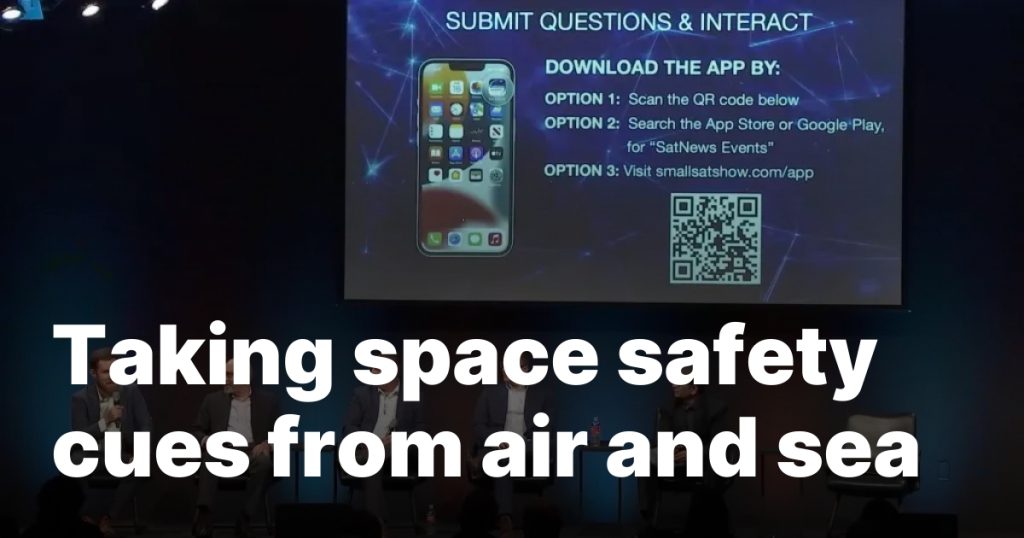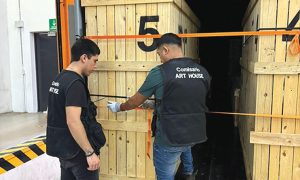TAMPA, Fla. — Parallels with aviation and maritime industries offer important insights for managing increasingly congested orbits, according to a Feb. 6 panel of space technology executives at the SmallSat Symposium in Silicon Valley.
“We have 10,000-plus satellites right now, projected to double every 22 months,” said Ahsun Murad, CEO of satellite network specialist Optimal Satcom, potentially leading to “about 100,000 satellites in seven years,” amid insatiable demand for connectivity.
There are also about 100,000 ships in the oceans, noted Rajeev Gopal, vice president of advanced defense programs at Hughes Network Systems, and somewhere around 30,000 to 40,000 commercial aircraft in service globally.
“There are unfortunate accidents here and there, but most of the time they work,” Gopal said, “but it also took us decades and centuries to evolve these rules.”
Tim Lynch, senior vice president and chief strategy officer for radiation-hardened electronics provider Frontgrade, pointed to how many ships and aircraft are fitted with universal sensors for providing location, communications and other critical data.
“I’m not saying that’s a solution but it’s certainly something to look at … we need to mature similar to that in space,” he said.
Although companies like LeoLabs use ground-based radars to track objects in orbit, Lynch said the ability to manage space traffic through observation alone has its limits.
“There’s going to have to be automation on satellites,” he said, and “they’re going to have to communicate with each other so that they can effectively maneuver, sort of like a blinker in your car — someone sees a blinker and they know you’re turning.”
Louis Christen, senior director of the proliferated systems operating unit for Northrop Grumman Space Systems, said companies currently work closely with space trackers at the U.S. Space Force’s 19th Space Defense Squadron for collision avoidance and conjunction analysis.
“But that job is going to get tougher and tougher as things get more dense,” Christen continued.
“I think autonomy is going to be really critical coming up here real soon.”
New vulnerabilities
Alongside the surge in satellites, growing amounts of debris present challenges that current tracking systems cannot fully address.
There are about 13,000 pieces of debris in the public catalogue for low Earth orbit (LEO), along with countless smaller fragments that are too tiny to track but still pose a threat to space operations.
And although LEO satellites are increasingly equipped with propulsion for mobility, Christen likened their thrust to a piece of paper resting on a hand.
“So we don’t have the ability to rapidly get out of the way,” he said, making autonomy even more important in increasingly crowded orbits.
While the number of satellites is approaching the scale of aircraft closer to Earth, LeoLabs founder and chief operating officer Dan Ceperley noted that the average closing speed for any two objects in LEO is 12 kilometers per second.
“We’re getting similar numbers, but much faster,” he said.
The panel also highlighted the growing risk of hostile activity in space, facilitated by technological advancements enabling close-proximity operations.
Satellite operators must not only mitigate the risk of accidental collisions but also guard against intentional threats.
Ceperley said LeoLabs has tracked “nesting doll” capabilities in orbit, where one spacecraft deploys a second satellite, which then deploys a third.
This underscores the need for continuous and more frequent monitoring of orbital activity.
“At the moment, there’s large gaps in the coverage of space domain awareness systems,” he said, adding that, within just a few hours, a spacecraft could deploy additional satellites that then separate and become undetected or unassociated.
“A few years ago, there was a zombie satellite that had been declared dead about six years prior, woke up, executed a large maneuver, pulled over near some other Russian satellites and proceeded to practice a bunch of proximity operations,” Ceperley added.
This raises concerns about what other undetected objects may be lingering in the debris environment.
However, the panel underlined cybersecurity as one of the biggest threats to orbital operations, mainly because of its relatively low barrier to entry.
“You can have a kid in a Starbucks and laptop start attacking your satellite,” Frontgrade’s Lynch quipped.
But while computing advances have introduced new risks for an increasingly connected world, they also provide the tools necessary to enhance autonomous protections against cyber and physical threats.








